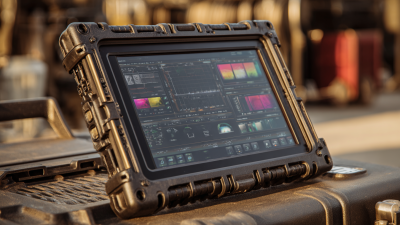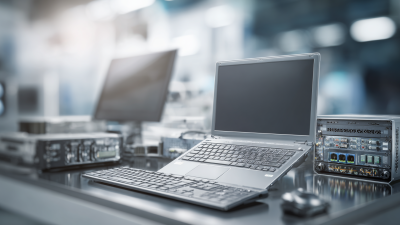How to Choose the Right Military Panel PC for Your Operations
As military operations increasingly rely on advanced technology for tactical advantages, selecting the right military panel PC becomes a critical decision for defense organizations and contractors alike. According to a recent report by MarketsandMarkets, the military computing market is projected to reach USD 27 billion by 2026, driven by the demand for enhanced processing power and ruggedization in harsh environments. Military panel PCs, known for their durability and ability to function effectively in extreme temperatures and conditions, are essential for applications ranging from command and control to real-time data analysis on the battlefield. Understanding the specific requirements of operational environments, such as size, display visibility, and connectivity options, is vital for optimizing mission success. This guide aims to equip decision-makers with the insights needed to choose the most appropriate military panel PC to meet their operational needs effectively.

Understanding the Key Features of Military Panel PCs for Operational Needs
When selecting a military panel PC for operational needs, understanding key features is essential for ensuring reliability and functionality in demanding environments. One of the foremost considerations is ruggedness. Military panel PCs are designed to withstand extreme conditions, including temperature fluctuations, moisture, and vibration. Look for models that meet military standards such as MIL-STD-810 for environmental durability, ensuring your device can operate effectively in the field.
Performance capabilities are another critical factor. Assess the processing power and memory requirements suited for your specific applications. A military panel PC should feature a powerful processor and ample RAM to handle real-time data processing and complex software. Additionally, consider display characteristics; high brightness screens are vital for visibility under direct sunlight, while touch capability can enhance usability with gloves, crucial in military settings. Connectivity options are also vital—ensure the panel PC supports various interfaces to integrate seamlessly with other military systems and devices, maximizing operational efficiency.

Evaluating Display Specifications for Optimal Visibility in Military Environments
When selecting a military panel PC, evaluating display specifications is crucial for ensuring optimal visibility in challenging environments. Military operations often take place in various conditions, including direct sunlight, low light, or extreme weather. Thus, the brightness of the display, typically measured in nits, is a vital factor. A screen with higher brightness levels enhances visibility outdoors while reducing glare, which is essential for maintaining situational awareness.
Additionally, the resolution and size of the display play significant roles in usability during operations. A higher resolution allows for clearer image quality and better detail recognition, which can be critical during missions. Furthermore, larger screens may facilitate easier multitasking and provide more space for visual data analysis, but they must remain portable enough for field use. Robustness is also key; military-grade panel PCs must withstand vibrations, shocks, and temperature variations, ensuring that the display retains functionality and readability in all operational contexts.
Display Specifications Comparison for Military Panel PCs
This bar chart compares the key display specifications for different military panel PCs, providing insights into resolution, brightness, contrast ratio, viewing angle, and response time vital for effective military operations.
Assessing Durability and Environmental Resistance for Extreme Conditions
When selecting a military panel PC for operations in extreme conditions, durability and environmental resistance are paramount factors to consider. Military-grade devices are designed to withstand harsh environments, which may include high or low temperatures, humidity, dust, and vibration. Ensure that the panel PC meets or exceeds MIL-STD-810G standards, which detail the test methods for evaluating equipment performance under such tough conditions. A ruggedized casing and robust materials will protect internal components from external threats, enabling reliable operation in the field.
In addition to physical durability, environmental resistance features such as waterproofing and shock absorption capabilities are crucial. Look for panel PCs with an IP rating of at least IP65, indicating they are dust-tight and protected against water jets. Furthermore, evaluating components like sealed connectors and connectors designed to minimize corrosion will help ensure longevity. By focusing on these critical elements, you can select a military panel PC that not only meets the operational needs but also thrives in extreme conditions, reducing the risk of equipment failure during crucial missions.
How to Choose the Right Military Panel PC for Your Operations - Assessing Durability and Environmental Resistance for Extreme Conditions
| Model | Durability Rating | Operating Temperature Range (°C) | Ingress Protection (IP) Rating | Weight (kg) | Dimensions (mm) |
|---|---|---|---|---|---|
| MPC-001 | MIL-STD-810G | -40 to 75 | IP67 | 3.5 | 300 x 200 x 50 |
| MPC-002 | MIL-STD-810H | -30 to 65 | IP65 | 4.2 | 350 x 250 x 60 |
| MPC-003 | MIL-STD-461F | -20 to 70 | IP54 | 5.0 | 400 x 300 x 70 |
| MPC-004 | MIL-STD-810G | -40 to 85 | IP68 | 3.8 | 320 x 220 x 55 |
Selecting the Right Processing Power for Mission-Critical Applications
When selecting the right processing power for military panel PCs, it is imperative to consider the specific needs of mission-critical applications. These applications often require robust processing capabilities to handle real-time data, complex computations, and demanding environmental conditions. Recent advancements highlight the importance of high-performance solutions, such as enhanced compute platforms designed to double memory capacity and improve bandwidth for greater transaction processing. This ensures that military operations can manage high volumes of data effectively, making technology a critical component of mission success.
Furthermore, the growing reliance on artificial intelligence in enterprise settings underscores the necessity for powerful processing units. With AI becoming a vital tool for operations, particularly in defense and intelligence applications, choosing military panel PCs equipped with advanced processing capabilities becomes essential. These systems must not only support mission-critical workloads but also provide the flexibility and scalability needed to integrate with emerging technologies. As the landscape of military operations increasingly incorporates innovative computing solutions, selecting the right processing power is key to maintaining operational efficiency and effectiveness in the field.

Exploring Connectivity Options for Enhanced Communication and Data Transfer
When selecting a military panel PC, one of the key considerations is the connectivity options that can significantly enhance communication and data transfer capabilities. According to a report by MarketsandMarkets, the military communication market is projected to grow from $29.36 billion in 2021 to $45.50 billion by 2026, indicating a rising need for robust and versatile connectivity solutions. Seamless connectivity is crucial for real-time data sharing, operational coordination, and mission success, making it essential to choose systems with diverse connectivity protocols such as Ethernet, Wi-Fi, and serial interfaces.
Tips: When evaluating panel PCs, prioritize those that offer options for modular expansion, allowing the integration of various communication modules as needed. Additionally, consider devices that support both wired and wireless connections to ensure reliability in diverse operational environments.
The integration of advanced connectivity features, such as 5G and tactical mesh networks, can further enhance communication capabilities. A study by Frost & Sullivan highlights that 5G implementation in military operations can enable transmission speeds of up to 10 Gbps, allowing for high bandwidth applications like video streaming and drone surveillance. Opting for panel PCs equipped with 5G capabilities can keep your operations ahead in dynamic scenarios.
Tips: Ensure the panel PC you choose is compatible with the latest standards and protocols to future-proof your investments in military technology.
Related Posts
-

10 Unique Industrial Panel PC Solutions for Buyers Worldwide
-

5 Features That Make Rugged Panel Computers the Best Choice for Tough Environments
-

10 Reasons Why Industrial Computing Products are the Best Choice for Your Business
-

Unlocking the Advantages of Military Panel PCs for Modern Defense Solutions
-

The Definitive Guide to Rugged Touch Panel PCs Enhancing Industrial Operations and Productivity
-

The Comprehensive Ultimate Guide to Choosing the Right Rugged Panel Computer for Your Needs

